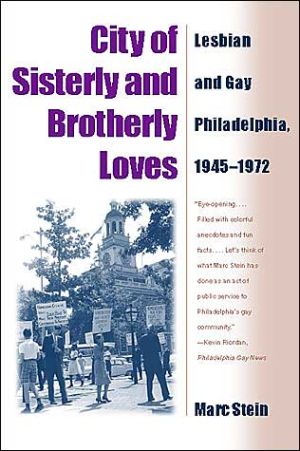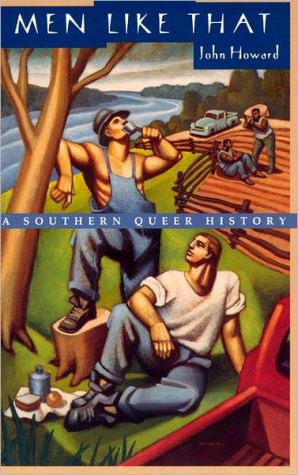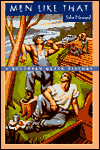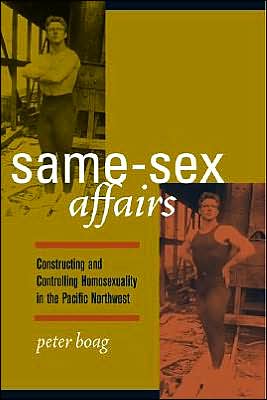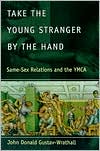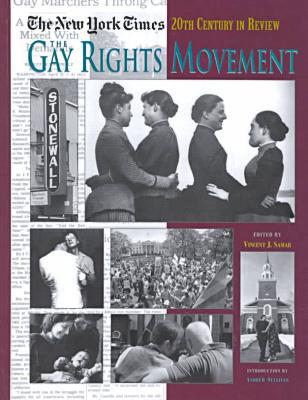City of Sisterly and Brotherly Loves: Lesbian and Gay Philadelphia, 1945-1972
In this pathbreaking history, Marc Stein takes an in-depth look at Philadelphia from the 1940s to the 1970s. What he finds is a city of vibrant gay and lesbian households, neighborhoods, commercial establishments, public cultures, and political groups. In doing so, Stein shatters the myth that lesbian and gay history began with the 1969 Stonewall riots in New York City and challenges the notion that only New York and San Francisco featured major lesbian and gay communities in the...
Search in google:
In this pathbreaking history, Marc Stein takes an in-depth look at Philadelphia from the 1940s to the 1970s. What he finds is a city of vibrant gay and lesbian households, neighborhoods, commercial establishments, public cultures, and political groups. In doing so, Stein shatters the myth that lesbian and gay history began with the 1969 Stonewall riots in New York City and challenges the notion that only New York and San Francisco featured major lesbian and gay communities in the pre-Stonewall era. Stein takes us on a tour through Philadelphia's bars, restaurants, bookstores, bathhouses, movie theaters, parks, and parades where lesbian and gay cultures thrived.We learn about the scientific experts, religious leaders, public officials, and journalists who attacked and ignored same-sex sexualities. And we read about the courageous people who fought back with strategies of everyday resistance and organized political activism. Stein argues against the idea that a conspiracy of silence surrounded gays and lesbians in the 1940s and 1950s. He shows that same-sex sexualities were regularly discussed in controversies concerning the tennis player Big Bill Tilden, the Walt Whitman Bridge, sex murders and crimes, and police raids. Philadelphians became national leaders in the gay and lesbian movement. They conducted sit-ins at Dewey's restaurant, organized pickets at Independence Hall, edited the movement's most widely circulated publications the Ladder and Drum, and pursued court cases all the way to the U.S. Supreme Court. Beautifully crafted and exceptionally well-written, Stein's book not only provides a new starting place for thinking aboutlesbian and gay history but also challenges readers to rethink twentieth-century urban history. Publishers Weekly Until now, historians have ignored Philadelphia's gay history, focusing instead on that of New York or San Francisco. An assistant professor of history at Toronto's York University, Stein argues that Philly's history is equally colorful and unique. Drawing on extensive interviews with people involved in the city's gay community over the last 60 years, local gay and mainstream publications and minutes from the meetings of both the city government and homosexual groups, Stein charts the growth of a vibrant pre-Stonewall gay and lesbian community, its subsequent political struggles and grassroots efforts and its emergence in the radical gay movement of the 1970s. He is at his best when describing the relationship between gay men and lesbians amid the city's complex network of neighborhoods and their successes and difficulties in working on political and social projects together. And when he turns his focus to smaller details--such as the Catholic Church's campaign against naming a new bridge after Walt Whitman or the impact on national politics of Drum, a 1960s Philly-based gay magazine--the result can be engaging and informative. In the end, however, this well-intentioned book too often reads like a doctoral thesis, with insights that are often obvious or academic. (May) Copyright 2000 Cahners Business Information.\|
ContentsList of FiguresAcknowledgmentsAbbreviationsIntroductionPart One - Everyday Geographies, 1945-19721. Your Place or Mine?: Residential Zones in the "City of Neighborhoods"2. "No-Man's Land": Commercial Districts in the "Quaker City"3. The Death and Life of Public Space in the "Private City"Part Two - Public Cultures, 1945-19604. "The Most Fabulous Faggot in the Land"5. The "Objectionable" Walt Whitman Bridge6. Rizzo's Raiders and Beaten BeatsPart Three - Political Movements, 1960-19697. "Come Out! Come Out! Wherever You Are!" 19608. "Earnestly Seeking Respectability," 1960-1963 9. "News for 'Queers' and Fiction for 'Perverts,'" 1963-196710. "The Masculine-Feminine Mystique," 1967-1969Part Four - Twin Revolutions? 1969-197211. "Turning Points," 1969-197012. Gay Liberation in the "Birthplace of the Nation," 1970-197113. Radicalesbian Feminism in "Fillydykia," 1971-1972ConclusionSexual Pride, Sexual ConservatismNotesIndex
\ Publishers Weekly - Publisher's Weekly\ Until now, historians have ignored Philadelphia's gay history, focusing instead on that of New York or San Francisco. An assistant professor of history at Toronto's York University, Stein argues that Philly's history is equally colorful and unique. Drawing on extensive interviews with people involved in the city's gay community over the last 60 years, local gay and mainstream publications and minutes from the meetings of both the city government and homosexual groups, Stein charts the growth of a vibrant pre-Stonewall gay and lesbian community, its subsequent political struggles and grassroots efforts and its emergence in the radical gay movement of the 1970s. He is at his best when describing the relationship between gay men and lesbians amid the city's complex network of neighborhoods and their successes and difficulties in working on political and social projects together. And when he turns his focus to smaller details--such as the Catholic Church's campaign against naming a new bridge after Walt Whitman or the impact on national politics of Drum, a 1960s Philly-based gay magazine--the result can be engaging and informative. In the end, however, this well-intentioned book too often reads like a doctoral thesis, with insights that are often obvious or academic. (May) Copyright 2000 Cahners Business Information.\|\ \ \ \ \ Library JournalThe history of sexual minorities has advanced to the point where historians can focus on tight studies of local conditions. Stein's detailed study of lesbian and gay Philadelphia from 1945 to 1972 will set the pattern for future studies of its kind. Theoretically sophisticated yet accessible, it is important beyond the bounds of concern of gays, lesbians, or Philadelphia. Stein (history, York Univ., Toronto) weaves a dense, richly documented narrative of the interactions of men and women and their political growing pains as they wage a human-rights struggle during tumultuous times and against an oppressive city government. He also portrays the development of a nascent and diverse subculture. Those who find historical writing too obscure for the average reader will appreciate Stein's evocative, insightful prose. By demonstrating how groups of various sexual and political orientations can work together, he amends the adage "the personal is political," adding that the local reveals the nation. Highly recommended.--David Azzolina, Univ. of Pennsylvania Lib., Philadelphia Copyright 2000 Cahners Business Information.\\\ \ \ Kate FullbrookAside from its virtues of charm, curiosity and fluency, Marc Stein's book on the history of lesbian and gay experience in post-war Philadelphia is interesting for the way that it skilfully embodies several dominant tendencies in recent American historiography.\ —Times Literary Supplement\ \
